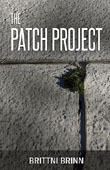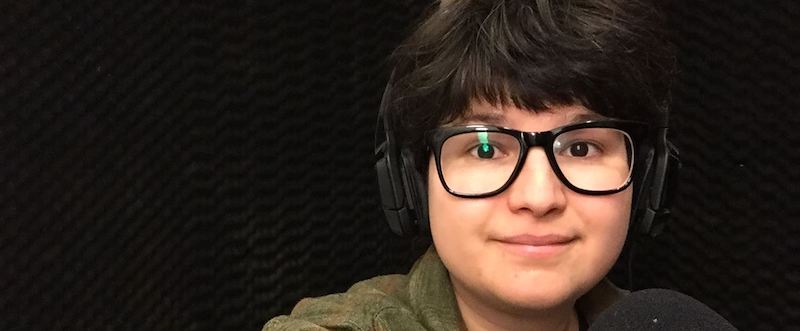Brittni Brinn was born Brittni Ann Carey in Winnipeg, Manitoba. She studied English and Drama at Concordia University College of Alberta (now Concordia University of Edmonton) before moving to Windsor, Ontario for graduate studies. She received her M.A. of Creative Writing in 2015. She co-hosted Hardcover: A Literary Podcast for two years and has written three plays for Paper-Knife Theatre. Besides books, her interests include coffee, songwriting, and cyborgs.
 What was the inspiration for The Patch Project?
What was the inspiration for The Patch Project?
When I started writing The Patch Project way back in 2011, I’d just started to get into post-apocalyptic fiction. A Canticle for Leibowitz, Do Androids Dream of Electric Sheep?, those kind of books. I really enjoyed the atmosphere of both novels and wanted to write something similar. But I also wanted to write a character-driven novel that didn’t depend on zombies or other tropes of the genre.
 You’ve written several plays as well as this novel. How does theatre and scene craft affect your novel writing? How has writing this novel affected your theatrical writing?
You’ve written several plays as well as this novel. How does theatre and scene craft affect your novel writing? How has writing this novel affected your theatrical writing?
Yes! I enjoy playwrighting, more than novel writing at times! I think my background in theatre plays into how I imagine scenes when I’m writing prose. I also tend to write long sections of dialogue before adding any description, staging the scenes from that point. I also like to map out “sets” for scenes when I get stuck, drawing out maps similar to stage diagrams I would use in actual productions.
The process of writing The Patch Project taught me a lot about polishing a story and the importance of having readers and editors to give feedback. It’s helped me be more comfortable sharing my plays in a workshop setting.
Listen to an audio excerpt from
The Patch Project
You talk about writing in a variety of different locations? What are some of the best writing environments for you, what is perhaps the most bizarre place you’ve found yourself writing, and how do these places affect the scenes you write?
Write where you are is kind of my work mantra. Back in 2011, I used to scribble in my notebook a lot while riding Edmonton transit (waiting for buses after my shift at the dinner theatre, taking buses to my friend’s house on the other side of town, the 45 minute train ride to work at a remote suburb Starbucks). I had an attic room in the house I shared with two other people, and an animation desk with an incredibly uncomfortable wooden stool. I look back on these experiences with nostalgia, those early days of trying to finish a novel for the first time.
Now, I usually write in the corner where my bookshelf lives, in the living room, or at the cafe I work at. I tend to write longer scenes in these spaces: I don’t feel rushed, and can fall more completely into the scene I’m working on.
 The most bizarre place I’ve found myself writing? Probably backstage during a musical production, sitting halfway down a staircase so I could stay out of the other actors’ way but not miss my cues!
The most bizarre place I’ve found myself writing? Probably backstage during a musical production, sitting halfway down a staircase so I could stay out of the other actors’ way but not miss my cues!
Can you give us a brief summary of your thesis Shuffle?
Shuffle is a novel-length multi-genre manuscript including scenes in prose, script-form for film and theatre, poetry, and images. The story follows Alexandra through three different timelines: her “hipster-central” young adulthood, her troubled childhood, and an imagined post-apocalyptic future. The scenes are mixed up, shuffled, as if they are being played on an iPod. The story troubles the boundaries between fact and fiction, past and present, and traditional heteronormative gender roles. It also touches on the fluidity of memory, and the relationship between humans and technology.
 How does this play out in your book The Patch Project? What sort of story might we get if we read the chapters in shuffle mode?
How does this play out in your book The Patch Project? What sort of story might we get if we read the chapters in shuffle mode?
I think many of the themes I explored in shuffle are also present in The Patch Project, which was written about three years prior. The more you write, the more you find out what it is you really want to write about!
The first half of The Patch Project integrates three separate story lines, but part two is linear for the most part. It would be interesting to see how mixing up the chapters in part two could influence the reader’s meaning-making, but I think it might be more confusing than anything.
What authors have had the greatest impact on your writing?
I read The Brothers Karamazov when I was 17, and it changed my life. I was a little obsessed with Dostoevsky in my undergrad, even did a self-directed capstone project on A Raw Youth, even though it technically wasn’t allowed because I was reading the English translation. Anyway, I’m a nerd, I know. His writing is dialogic, meaning many-voiced, allowing each character to have their own viewpoint as opposed to the author telling you what the moral of the story is. His dinner scenes often feel like scenes from a play, along with introspective dreams and a focus on how ideas shape character. All these elements, along with themes of suffering followed by a shade of redemption, are probably what I’ve taken the most from.
I also highly regard the fiction Madeline L’Engle, C.S Lewis, Neil Gaiman, Margaret Atwood, and Emily St. John Mandel.
What is next for Brittni?
I’m working on a sequel! Hopefully, I’ll be able to finish writing and editing it over the summer. Over the next month, I’m going to be directing Yellow Vines, an original play by Linda Collard. I’m also doing some readings in the Windsor, Ontario area to promote The Patch Project. And hopefully sleeping? Sometimes?

![]()
Learn more about Brittni Brinn
Website: Brittni Brinn
Follower her on Facebook and Twitter

